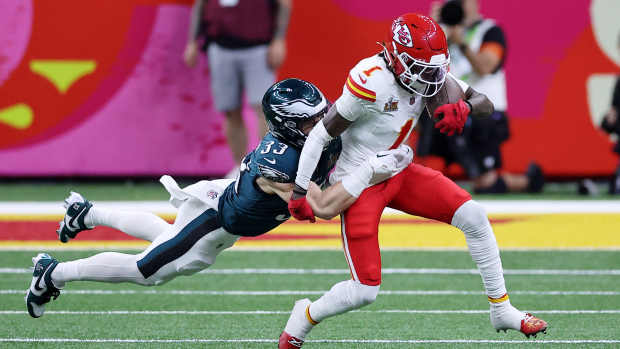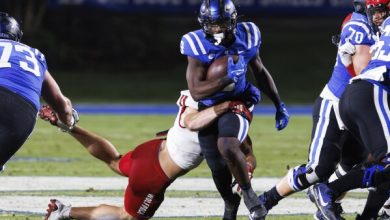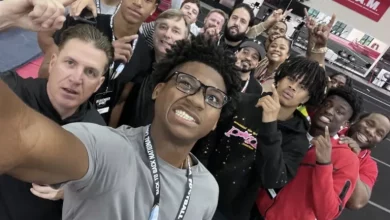Joe Burrow admits his time at Ohio State may have looked very different in today’s era of college football

Joe Burrow, a name synonymous with college football excellence, made a tremendous impact during his time at LSU, culminating in a national championship and a Heisman Trophy. However, before Burrow became the superstar that we know today, he spent a significant portion of his college career at Ohio State. During that time, Burrow was a highly touted quarterback prospect but faced challenges, including competition at a crowded quarterback room that limited his opportunity to take the starting job.
Looking back, Burrow has reflected on his time at Ohio State, and in light of the rapid changes in college football today, he believes his journey might have been different had he played in the current era. With the advent of the transfer portal, NIL (Name, Image, and Likeness) opportunities, and the increased focus on player empowerment, Burrow’s path might have taken a much different trajectory in today’s college football landscape.
Joe Burrow’s Journey to Ohio State
Joe Burrow arrived at Ohio State in 2015 as a highly regarded recruit from Athens, Ohio. The son of a football coach, Burrow was no stranger to the sport and brought with him the pedigree and work ethic that college football programs covet. He joined a loaded quarterback room that included future NFL talents like J.T. Barrett and Cardale Jones, making it difficult for Burrow to immediately seize a starting role.
At Ohio State, Burrow served as a backup for several years, waiting for an opportunity that never fully came to fruition. Despite the fact that Burrow had all the tools to succeed – including excellent vision, strong arm strength, and mobility – he found himself sitting behind Barrett, who led Ohio State to a national championship, and Jones, who was instrumental in the team’s success during his time as the starter.
While Burrow’s talent was undeniable, he did not receive the starting job during his time at Ohio State, which led him to make the decision to transfer to LSU in 2018. There, Burrow would find the perfect situation, not only securing the starting role but also flourishing in a system that showcased his skills in ways that ultimately led him to stardom.
The Changing Landscape of College Football
Burrow’s story is far from unique. Many college athletes face difficult decisions as they navigate the cutthroat world of college football. The transfer process, once a challenging and cumbersome journey, has become far easier in the modern era. Thanks to the transfer portal, players now have the ability to switch programs without sitting out a year, as was previously required. This development has dramatically shifted the dynamics of college football, making it much easier for athletes to find a better fit for their skills, and for programs to fill roster gaps quickly.
In Burrow’s time, the idea of transferring to another program wasn’t as common, and a player like him had fewer options to play immediately. The stigma surrounding transferring – especially for a player who might have once been seen as a potential future star – was much more significant. Today, players like Burrow would likely have more control over their future and a clearer path to success at another program if they felt they were not being given the opportunity they deserved.
One of the most significant changes to college football in recent years is the NIL era. This new landscape allows athletes to capitalize on their name, image, and likeness, earning money from endorsement deals and other business opportunities while still in college. If Burrow had entered college football in this new environment, he would have undoubtedly had more opportunities to build his brand and capitalize on his on-field success much earlier in his career.
While Burrow wasn’t able to benefit from the NIL era, his success at LSU, including a Heisman Trophy and national championship, has made him one of the most marketable athletes in the world today. He is now a well-known figure, both in football and in the broader sports world, and has taken advantage of endorsement opportunities as an NFL star. Had Burrow been in college football during the NIL era, the financial benefits could have been even more significant during his time at LSU, allowing him to further enhance his profile earlier.
The Transfer Portal and Burrow’s Path to LSU
The decision to transfer to LSU was, at the time, a difficult one for Burrow, especially considering the program he was leaving behind at Ohio State. In hindsight, however, it was a decision that changed his life. Had Burrow been in today’s college football environment, he might have had an easier time navigating the decision to transfer, possibly making the move even sooner.
While Burrow undoubtedly made the right call by transferring to LSU, where he would become the starting quarterback and set the college football world on fire with his 2019 performance, the environment at the time made it more complicated for a player in his position. Without the transfer portal making it easier to switch programs and without the ability to immediately contribute at a new school, Burrow’s decision was fraught with uncertainty.
Today, athletes have greater flexibility and access to a plethora of options. If a player feels they are not getting the playing time or opportunity they deserve, they can now easily enter the transfer portal and explore other options. For Burrow, having the option of the transfer portal in his time would have allowed him to more quickly find a team that would utilize his talents more effectively.
The Impact of NIL on Player Empowerment
NIL has significantly impacted the college football landscape, giving players more autonomy and opportunities to capitalize on their success. Players are now able to enter endorsement deals, sell merchandise, and promote their own brand, which was unimaginable during Burrow’s time at Ohio State and early years at LSU.
Had Burrow been in the NIL era, he would likely have attracted significant attention from companies and brands during his Heisman-winning 2019 season. The financial opportunities would have been immense, especially considering his national prominence during LSU’s historic season. Burrow’s appeal as a charismatic, marketable player would have made him a prime candidate for endorsements, and he would have been able to capitalize on his success in college football in ways that previous generations of players never could.
NIL, in essence, would have provided Burrow with financial independence and the ability to navigate his college career on his own terms. This is a concept that has dramatically changed the power dynamic in college football. Players now have a say in their financial futures, and that control has made the sport more player-centric.
The Current College Football Landscape and Player Empowerment
The changes in college football have empowered players in ways that were previously unimaginable. For Joe Burrow, a player of his caliber today would have the chance to compete at the highest level, benefit from NIL, and have more control over their path through the transfer portal. This means that players no longer have to wait their turn or stay in a system that doesn’t suit their talents.
Burrow’s experience highlights the benefits of a changing college football landscape that increasingly focuses on player empowerment and opportunity. With the shift in how players can navigate their careers, future recruits and players will have greater freedom to shape their path based on what they feel is best for their development, both on and off the field.
Had Burrow’s time at Ohio State been in the modern college football era, he might have been more willing to explore opportunities elsewhere sooner, which could have allowed him to develop into a star at a faster pace. This, in turn, may have altered the trajectory of his career and the way his legacy in college football is viewed.
Burrow’s Legacy and Lessons for Future Players
As Burrow continues to shine in the NFL, he stands as a reminder of how timing, circumstance, and the structure of college football can significantly impact a player’s career. While his path to stardom may have been unconventional, it was also the right one for him. Today’s college football players, however, have more tools at their disposal to manage their careers, empowering them to make decisions based on their personal and professional growth.
For players who find themselves in situations similar to Burrow’s at Ohio State, the transfer portal offers new hope and flexibility. For those who are unable to secure immediate starting positions or feel they need a new opportunity to flourish, today’s system allows them the ability to pivot and continue their careers in a way that best suits their goals.
Burrow’s story, which began with adversity at Ohio State, ultimately led to success at LSU, showing the importance of perseverance and adaptability. Today’s players, however, have more power and tools to ensure they can make choices that align with their aspirations – a luxury that Burrow never had when he was starting out. As college football continues to evolve, Burrow’s experience serves as a guiding light for future generations of players navigating their own paths to greatness.









